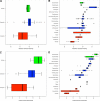Origins of specificity and promiscuity in metabolic networks
- PMID: 22052908
- PMCID: PMC3243566
- DOI: 10.1074/jbc.M111.274050
Origins of specificity and promiscuity in metabolic networks
Abstract
How enzymes have evolved to their present form is linked to the question of how pathways emerged and evolved into extant metabolic networks. To investigate this mechanism, we have explored the chemical diversity present in a largely unbiased data set of catalytic reactions processed by modern enzymes across the tree of life. In order to get a quantitative estimate of enzyme chemical diversity, we measure enzyme multispecificity or promiscuity using the reaction molecular signatures. Our main finding is that reactions that are catalyzed by a highly specific enzyme are shared by poorly divergent species, suggesting a later emergence of this function during evolution. In contrast, reactions that are catalyzed by highly promiscuous enzymes are more likely to appear uniformly distributed across species in the tree of life. From a functional point of view, promiscuous enzymes are mainly involved in amino acid and lipid metabolisms, which might be associated with the earliest form of biochemical reactions. In this way, results presented in this paper might assist us with the identification of primeval promiscuous catalytic functions contributing to life's minimal metabolism.
Figures





Similar articles
-
Metabolite-Enzyme Coevolution: From Single Enzymes to Metabolic Pathways and Networks.Annu Rev Biochem. 2018 Jun 20;87:187-216. doi: 10.1146/annurev-biochem-062917-012023. Annu Rev Biochem. 2018. PMID: 29925259 Review.
-
Network context and selection in the evolution to enzyme specificity.Science. 2012 Aug 31;337(6098):1101-4. doi: 10.1126/science.1216861. Science. 2012. PMID: 22936779 Free PMC article.
-
Shining a light on enzyme promiscuity.Curr Opin Struct Biol. 2017 Dec;47:167-175. doi: 10.1016/j.sbi.2017.11.001. Epub 2017 Nov 21. Curr Opin Struct Biol. 2017. PMID: 29169066 Review.
-
Molecular signatures-based prediction of enzyme promiscuity.Bioinformatics. 2010 Aug 15;26(16):2012-9. doi: 10.1093/bioinformatics/btq317. Epub 2010 Jun 15. Bioinformatics. 2010. PMID: 20551137
-
Engineering catalytically promiscuous enzymes to serve new functions.Biotechnol Adv. 2025 Sep;82:108601. doi: 10.1016/j.biotechadv.2025.108601. Epub 2025 May 13. Biotechnol Adv. 2025. PMID: 40374085 Review.
Cited by
-
Current understanding of the formation and adaptation of metabolic systems based on network theory.Metabolites. 2012 Jul 12;2(3):429-57. doi: 10.3390/metabo2030429. Metabolites. 2012. PMID: 24957641 Free PMC article.
-
Amy63, a novel type of marine bacterial multifunctional enzyme possessing amylase, agarase and carrageenase activities.Sci Rep. 2016 Jan 4;6:18726. doi: 10.1038/srep18726. Sci Rep. 2016. PMID: 26725302 Free PMC article.
-
Minimal catalytic dissipative assemblies via cooperation of an amino acid, a nucleobase precursor and a cofactor.Chem Sci. 2025 Mar 24;16(18):7838-7846. doi: 10.1039/d5sc00827a. eCollection 2025 May 7. Chem Sci. 2025. PMID: 40177318 Free PMC article.
-
A substrate ambiguous enzyme facilitates genome reduction in an intracellular symbiont.BMC Biol. 2014 Dec 20;12:110. doi: 10.1186/s12915-014-0110-4. BMC Biol. 2014. PMID: 25527092 Free PMC article.
-
NDM-1, the ultimate promiscuous enzyme: substrate recognition and catalytic mechanism.FASEB J. 2013 May;27(5):1917-27. doi: 10.1096/fj.12-224014. Epub 2013 Jan 30. FASEB J. 2013. PMID: 23363572 Free PMC article.
References
Publication types
MeSH terms
Substances
LinkOut - more resources
Full Text Sources
Other Literature Sources

